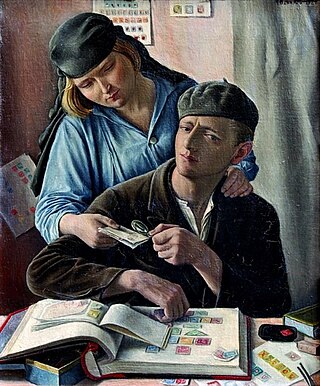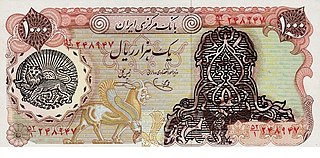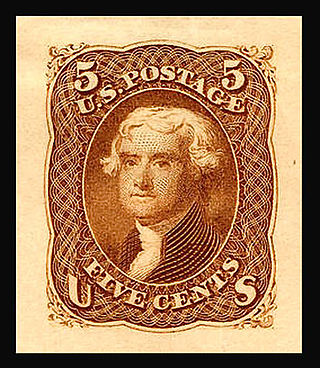
A postage stamp is a small piece of paper issued by a post office, postal administration, or other authorized vendors to customers who pay postage. Then the stamp is affixed to the face or address-side of any item of mail—an envelope or other postal cover —which they wish to send. The item is then processed by the postal system, where a postmark or cancellation mark—in modern usage indicating date and point of origin of mailing—is applied to the stamp and its left and right sides to prevent its reuse. Next the item is delivered to its addressee.

Stamp collecting is the collecting of postage stamps and related objects. It is an area of philately, which is the study of stamps. It has been one of the world's most popular hobbies since the late nineteenth century with the rapid growth of the postal service, as a stream of new stamps was produced by countries that sought to advertise their distinctiveness through their stamps.

An overprint is an additional layer of text or graphics added to the face of a postage or revenue stamp, postal stationery, banknote or ticket after it has been printed. Post offices most often use overprints for internal administrative purposes such as accounting but they are also employed in public mail. Well-recognized varieties include commemorative overprints which are produced for their public appeal and command significant interest in the field of philately.

The Penny Black was the world's first adhesive postage stamp used in a public postal system. It was first issued in the United Kingdom on 1 May 1840 but was not valid for use until 6 May. The stamp features a profile of Queen Victoria.
This is a list of philatelic topics.

Postage stamps and postal history of Great Britain surveys postal history from the United Kingdom and the postage stamps issued by that country and its various historical territories until the present day.

The Prince Consort Essay was a surface printed printer's sample stamp created in 1851 as an example of the surface printed stamps that Henry Archer proposed to print and perforate under contract with the British government at a lower price than the current printing firm of Perkins Bacon. The Prince Consort stamps were provided by the artist Robert Edward Branston, from an engraving executed by Samuel William Reynolds.
North Borneo, located in the northern part of the island of Borneo, was a British protectorate from 1888 and a British Crown colony after 1946.

A revenue stamp, tax stamp, duty stamp or fiscal stamp is a (usually) adhesive label used to designate collected taxes or fees on documents, tobacco, alcoholic drinks, drugs and medicines, playing cards, hunting licenses, firearm registration, and many other things. Typically, businesses purchase the stamps from the government, and attach them to taxed items as part of putting the items on sale, or in the case of documents, as part of filling out the form.

A test stamp is a label resembling a postage stamp that is used by postal authorities for testing equipment. They generally have the same size and shape as regular stamps, but with a minimal design. Although not normally made available to the general public, some have found their way into private hands, and they are a recognised stamp collecting speciality.

A dummy stamp is a stamp-like label which is not valid for postal use. Dummy stamps are a form of cinderella stamp and the two principal types are test or training stamps, used to test postal equipment or train postal workers, and printer's sample stamps created to promote or demonstrate the printing capabilities of a stamp printer.

In philately, an essay is a design for a proposed stamp submitted to the postal authorities for consideration but not used, or used after alterations have been made. By contrast, a proof is a trial printing of an accepted stamp.

Waterlow and Sons Limited was a major worldwide engraver of currency, postage stamps, stocks and bond certificates based in London, Watford and Dunstable in England. The company was founded as a family business in 1810. It was acquired in 1961 by De La Rue.

A specimen stamp is a postage stamp or postal stationery indicium sent to postmasters and postal administrations so that they are able to identify valid stamps and to avoid forgeries. The usual method of invalidating the stamps is either overprinting in ink or perforating the word Specimen across the stamp and where English is not the common language, the words Muestra (Spanish), Monster (Dutch), Muster (German) or Образец have been used instead.

In philately a Die Proof is a printed image pulled directly from the master die for an engraved stamp.

Bolivia was formerly known as Upper Peru and became an independent republic on 6 August 1825. It has produced its own postage stamps since 1867. Stamps from Bolivia are marked as Correos de Bolivia. Tensions between Chile and Bolivia have influenced both countries' stamps and postal history.

'Seahorses' is the name used to refer to the United Kingdom high value definitive postage stamps issued during the reign of King George V.

The Postal Union Congress (PUC) £1 stamp is one of a series of postage stamps of Great Britain issued in 1929. It is one of the classics of British philately and has been described as one of the most beautiful British stamps ever issued. The stamp was only the second British commemorative stamp to be issued. The first were the British Empire Exhibition postage stamps of 1924–25.

Revenue stamps of British Guiana refer to the various revenue or fiscal stamps, whether adhesive or directly embossed, which were issued by British Guiana prior to the colony's independence as Guyana in 1966. Between the 1860s and 1890s, the colony issued Inland Revenue and Summary Jurisdiction stamps, while revenue stamps and dual-purpose postage and revenue stamps were issued during the late 19th and 20th centuries. In around the 1890s or 1900s, British Guiana possibly issued stamps for taxes on medicine and matches, but it is unclear if these were actually issued. Guyana continued to issue its own revenue stamps after independence.


















